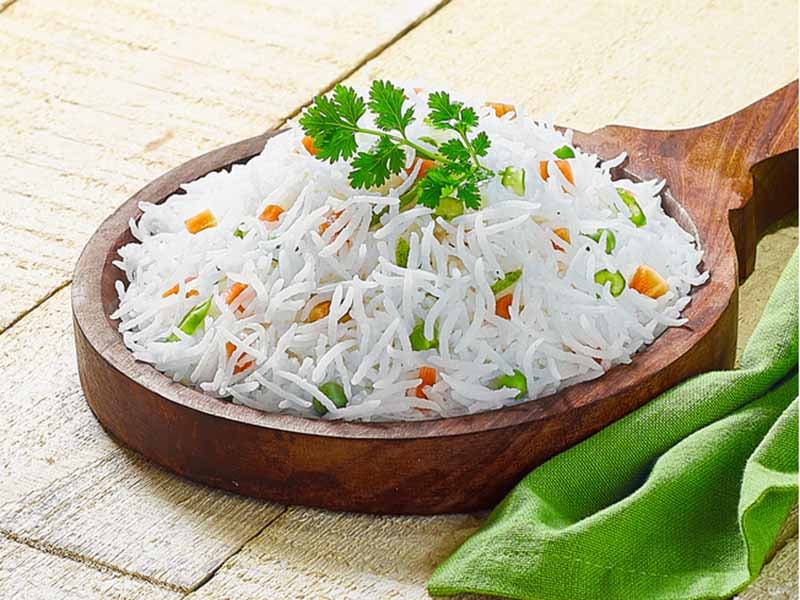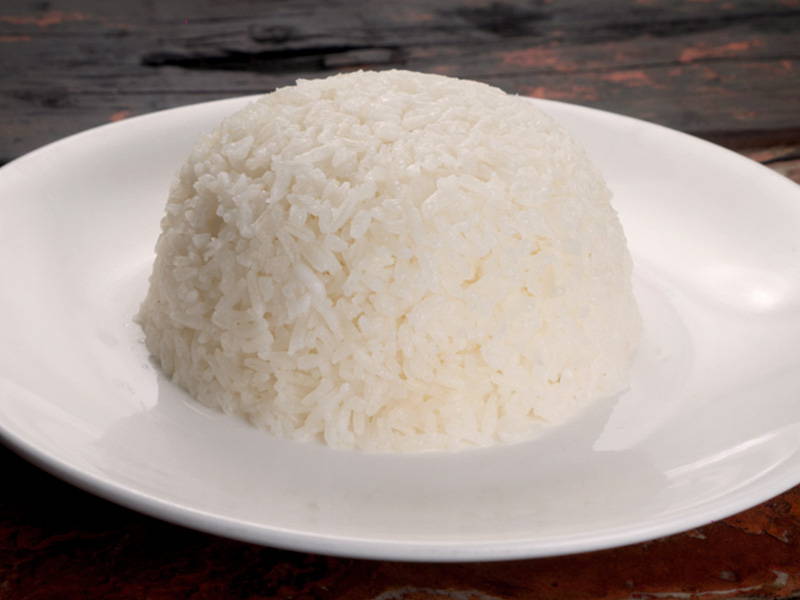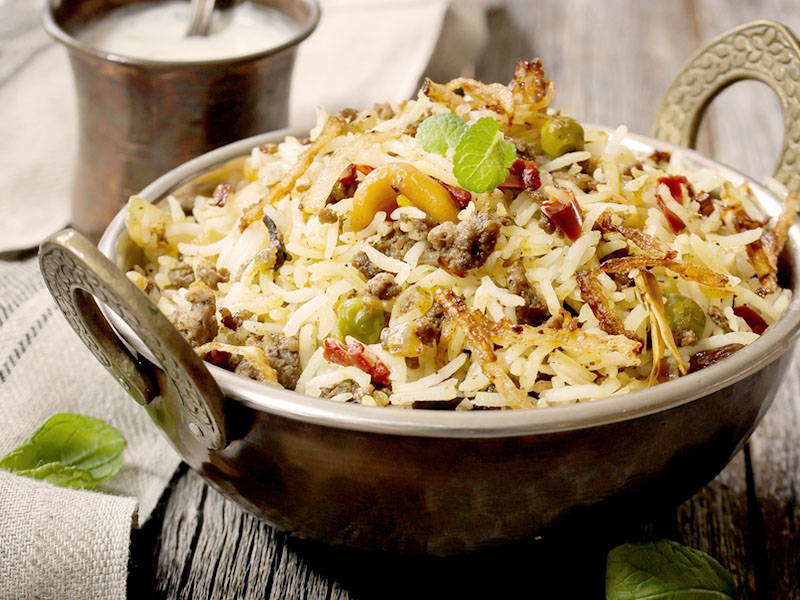
Basmati Rice vs. White Rice: What’s the Difference?
Key Takeaways
- Both regular white rice and white basmati rice are refined grains that have had the bran and germ removed. For this reason, they are lower in fiber and nutrients compared to brown rice and other whole grains.
- Due to their low fiber and high carb content, both rice varieties may cause insulin and blood sugar spikes. In the long run, they may increase your risk of metabolic syndrome and diabetes. These conditions are major risk factors for heart disease.
- Since white rice is low in fiber, it’s unlikely to cause bloating and stomach pain. Unlike brown rice, it doesn’t contain phytic acid and other anti-nutrients that reduce mineral absorption.
- White rice can be a good source of carbs when consumed in moderation. Serve it with lean beef, poultry, or other high-protein foods to slow down carbohydrate absorption into your system.
- Quinoa, amaranth, sweet potatoes, oats, and other high-carb foods are a lot healthier and more nutritious than basmati or white rice.
Fragrant white basmati rice boasts an amazing flavor and makes a great addition to Indian dishes, salads, and even steak, but is it really that healthy? And how does it compare to white rice? Is there any difference between the two?
Whether you eat rice for bulking up or to get your daily carbs, you may wonder which variety is best. When it comes to basmati rice vs. white rice, there are some nutritional differences you should be aware of.

For example, basmati rice is significantly higher in calories and carbs than white rice. This means it’s ideal for those trying to put on pounds, but not so good for cutting.
Currently, about 70% of the world’s basmati rice production comes from India. Its distinctive flavor is given by 2-acetyl-1-pyrroline, an aroma compound that’s also used in Indian spices, jasmine rice, and white bread.
All rice varieties are gluten-free and can be safely consumed by those with wheat allergy or Celiac disease. However, some brands are processed in factories that handle wheat flour and other grain products, so they may contain traces of gluten.
Your best is to read the labels and choose organic varieties.
The question is: how does basmati rice compare to white rice? Are there better options available? In today’s post, we’ll compare these popular rice varieties to help you make an informed decision.
We’ll break down the nutritional value of rice, list its potential health benefits and drawbacks, and see what the research says. Plus, our team has put together a list of alternatives to rice.
And don’t forget to check out our comparison of Brown Rice vs. White Rice, Jasmine Rice Vs White Rice, and Basmati Rice vs. Brown Rice,
Let’s get into it!
What Is Basmati Rice?
This type of aromatic rice originates in southern Asia and it’s traditionally served alongside roasted or braised meats, curries, and Indian dishes.
The grain is long and narrow, with a firm texture, pointy ends and a distinctive nutty flavor. It can be brown, red or white and boasts a spicy fragrance.

As you might have guessed, brown basmati rice is less processed than its white counterpart and doesn’t have the bran removed. However, there isn’t a significant difference between the two from a nutritional standpoint.
One-quarter cup of white basmati rice (uncooked) provides the following nutrients:
- 160 calories
- 3 grams of protein
- 36 grams of carbs
- 1 gram of fiber
That’s about a half-cup of cooked rice as the grain doubles in size when boiled or steamed. The same goes for all rice varieties.
The same amount of brown basmati rice delivers:
- 160 calories
- 4 grams of protein
- 2 grams of fat
- 35 grams of carbs
- 1 gram of fiber
As you can see, both types of rice have similar nutritional values. Brown basmati rice is slightly higher in protein and fat, but the difference is negligible. Depending on the brand and cultivar, some varieties may provide more fiber and minerals.
Red basmati rice is even healthier, according to a report published in Food Chemistry. As the researchers note, this functional food is higher in phenolic compounds and anthocyanins than its white counterpart. Additionally, it has a lower glycemic index and greater antioxidant activity.
Key Nutrients in Basmati Rice
In addition to protein and carbs, basmati rice is rich in bioactive compounds.
A review published in the International Journal of Molecular Science compared several rice varieties, including Basmati Super, Basmati 2000 and Basmati Pak.
Their fatty acid content varied between 18,240 milligrams and 25,840 milligrams per kilogram, with oleic acid, linoleic acid, and palmitic acid being the most abundant fats.
As it turns out, this grain boasts large doses of antioxidants.

The above review showed that it’s a good source of beta-sitosterol, stigmasterol, campesterol, and other phytosterols.
These nutrients have been shown to lower bad cholesterol by 8 to 15% when consumed in doses of 1.5 to 3 grams per day, according to a research paper featured in Clinical Nutrition.
Current evidence indicates that plant sterols may protect against gastric, lung, and breast cancer. These bioactive compounds are similar to cholesterol in structure and function and may significantly decrease LDL (the “bad”) cholesterol levels.
Basmati rice also provides tocotrienols and tocopherols. These antioxidants have been studied for their ability to suppress tumor growth.
Its fatty acid content shouldn’t be ignored. Oleic acid, for example, reduces intestinal cholesterol absorption, which may help lower the risk of cardiac events. Like other monounsaturated fats, it may help improve body composition and reduce insulin resistance.
However, basmati contains negligible amounts of oleic acid compared to olive oil, avocado oil, or almond oil. If you’re trying to get more fats in your diet, there are smarter ways to do it.
To keep your heart healthy, consider taking omega-3s and switch to a diet rich in good fats. Old School Labs’ Vintage Balance offers optimum doses of omega-3, omega-6, and omega-9 fatty acids. These nutrients support cardiovascular function, keep your brain sharp, and fight inflammation.
The Scoop on White Rice
Now let’s talk about white rice. Although it’s not the healthiest food, it has its perks. After all, there’s a reason why world-famous bodybuilders eat rice at most meals, especially when bulking up.
Samir Bannout, the Lion of Lebanon, states clearly that white rice is unlikely to cause weight gain when consumed as part of a balanced diet. If you have a belly, that’s because you eat high GI carbs that spike insulin, not because of rice in particular.

White rice has a moderate glycemic index, point out the expert at Harvard Medical School. The same goes for white and sweet potatoes, couscous, and whole grains. Brown rice is even better due to its high fiber content, which slows down sugar absorption into the bloodstream.
Donuts, crackers, candies, cakes, white bread, pastries, and breakfast cereals all have high glycemic index values. These are the foods you should cut from your diet to stay lean.
White Rice and Athletic Performance
Many athletes rely on white rice as their primary source of carbs. This grain is rich in simple carbs that help replenish your glycogen stores and fuel physical training.
As you probably know, intense workouts deplete the body’s glycogen stores, which in turn, may delay the recovery process and affect athletic performance. After training, you need a quick source of protein and carbs to mitigate these effects.

That’s where white rice comes in handy.
It not only provides an immediate source of fuel, but it’s also lower in fiber compared to brown rice. This means that it won’t cause bloating and digestive discomfort like brown rice does.
Furthermore, white rice doesn’t contain phytic acid and other anti-nutrients that inhibit mineral absorption into the bloodstream. Unlike brown rice, it has the bran removed.
Phytic acid, for example, occurs naturally in the bran. This means that white rice is a “safe” food for athletes with a sensitive stomach or digestive issues.
However, if you’re spending most of your day sitting, you don’t need those extra carbs.
Does White Rice Provide Any Nutrients?
A half-cup of cooked white rice, or a quarter cup of uncooked rice, has only 103 calories. That’s significantly less compared to basmati rice. You’ll also get the following nutrients:
- 2.1 grams of protein
- 0.2 grams of fat
- 22.3 grams of carbs
- 0.3 grams of fiber
- 4% of the DV (daily value) of zinc
- 5% of the DV of iron
- 2% of the DV of magnesium
- 16% of the DV of manganese
- 11% of the DV of selenium
This grain is relatively high in B-complex vitamins, especially thiamin, niacin, and folate.
Your body needs these micronutrients to convert food into energy. B vitamins also maintain cell function and support the formation of red blood cells, hormones, and cholesterol.

Thiamin, for example, regulates muscle contraction and helps your body break down carbs for energy, as reported by the U.S. National Library of Medicine. Low levels of this nutrient may cause fatigue, nerve damage, and overall weakness.
Manganese, one of the most abundant minerals in white rice, promotes the formation of antioxidant enzymes, among other functions. It also plays a role in bone development and wound healing.
Individuals who are deficient in manganese have a greater risk of osteoporosis, glucose intolerance, and diabetes.
All in all, white rice has its place in a balanced diet. It’s also a good choice for those trying to limit their fat intake. If you cook it without any butter or oil, you’ll get a fat-free dish.
What Does the Research Say?
Both white rice and white basmati rice are refined grains, meaning that their bran and germ have been removed. Therefore, they may cause blood sugar spikes.
However, rice isn’t the worst food you can get. Calorie per calorie, it’s more nutritious than cookies, white pasta or bagels and has no trans fats.
Like with everything else, moderation is the key.
A 2017 review published in Heart Asia states that white rice doesn’t increase the risk of heart disease, stroke, or diabetes. However, it may contribute to the onset of metabolic syndrome in certain populations, which in turn, may raise diabetes risk.

Another review, which was featured in Public Health Nutrition, has found that white rice may increase the risk of chronic diseases in women and reduce the odds of early death in men.
Other studies indicate a positive association between this high-carbohydrate food, metabolic syndrome, and diabetes.
As it turns out, white rice consumption doesn’t cause heart disease, but it may increase the risk of cardiovascular problems due to its negative impact on blood sugar levels. Diabetes and heart disease are strongly connected.
In a large-scale study conducted on 197,228 men and women, those who swapped one-third of a cup of white rice for brown rice had a 16% lower risk of diabetes.
As mentioned earlier, brown rice is higher in fiber, leading to a gradual increase in blood sugar levels. Therefore, it’s less likely to cause insulin and blood glucose spikes than its white counterpart.
Does White Rice Cause Weight Gain?
Whether we’re talking about white basmati rice or regular white rice, it’s important to know how it affects body weight and metabolism. Again, the research is mixed.
A study published in ARYA Atherosclerosis in 2013 has found no association between white rice consumption and body weight, body mass index, or abdominal obesity.

However, researchers point out at other studies showing that refined grains have a higher glycemic load, which may lead to insulin and blood glucose spikes. As a result, they may inhibit fat breakdown, promote the formation of new fat cells, and contribute to obesity.
Note that rice protein has a positive impact on triglyceride metabolism, according to the above review. Because of this, it may help reduce fat mass and body weight.
Another study, which was published in the Journal of the American College of Nutrition, suggests the opposite. After assessing the eating habits of 415 teenage women, scientists have found that a positive association between rice consumption and obesity.
Furthermore, diets rich in white rice, but not brown rice, may increase the risk of gaining 6.6 pounds or more over the course of one year, according to a study conducted on Japanese workers.

Based on these findings, it’s hard to tell whether white rice promotes or inhibits weight gain. At the end of the day, it all comes down to what your overall diet looks like. Your metabolism and insulin sensitivity play a role too.
If you’re trying to get leaner, white rice isn’t the best choice. But it can be a good source of carbs when bulking up.
However, there are plenty of other high-carb foods with more protein, fiber, and micronutrients than rice. We’ll discuss this later, so keep reading.
Basmati Rice vs. White Rice: The Final Verdict
Now that you know more about basmati rice vs. white rice, you may wonder which one is best. Except for their caloric values, both types of rice are similar from a nutritional perspective.
White basmati rice is higher in calories and carbs compared to regular white rice. It also contains slightly more protein, but the difference is too small to make a difference.

Furthermore, both types of grains are highly processed and may cause blood sugar spikes due to their low fiber content. Some studies suggest that white rice in all its forms may contribute to obesity and diabetes.
Whole-grain varieties are a better choice as they provide more fiber and nutrients, but they also contain phytic acid, a compound that inhibits mineral absorption.
As you see, there’s no clear winner. The key is to enjoy rice as part of a balanced meal plan. Consider the recommended portion size as well.
One serving of cooked rice is half a cup. If you fill your plate, you’ll likely experience blood sugar spikes. Ideally, serve rice with chicken, lean beef, fish, or other high-protein foods to slow down carbohydrate absorption into your system.
Healthy High-Carb Alternatives to Rice
When it comes to filling up on carbs, rice isn’t your only option. Sweet potatoes, quinoa, oat or wheat bran, oatmeal, bananas, mangoes, goji berries, farro, barley, and bulgur wheat are all an excellent choice.
These foods are not only rich in carbs, but they also boast a higher nutritional value than rice.

Quinoa, for example, provides 111 calories, 4.1 grams of protein, 1.8 grams of fat, and 19.7 grams of carbs, including 2.6 grams of fiber, per serving (a half-cup). It also supplies the following nutrients:
- 14% of the DV of magnesium
- 9% of the DV of zinc
- 8% of the DV of iron
- 3% of the DV of potassium
- 25% of the DV of manganese
- 20% of the DV of copper
According to a recent review in Molecular Nutrition and Food Research, quinoa is rich in phytochemicals that may lower the risk of diabetes, heart disease, obesity, cancer, and other ailments related to oxidative stress. Amaranth, a pseudo-grain, is just as beneficial.
Furthermore, eating just 1.7 ounces of quinoa per day may reduce triglyceride levels in overweight and obese individuals.
Choose Your Carbs Wisely
When it comes to basmati rice vs. white rice, both grains have similar nutritional values. They’re relatively low in calories, fiber, and protein and supply hefty doses of carbs. Choosing one over another is a matter of personal preference.

Rice isn’t the worst food out there. It all comes down to how you cook and serve it.
Risotto with butter, parmesan, and heavy cream, for instance, is a calorie bomb. Steamed rice with chicken breast, by contrast, is a healthy dish that will fuel your workouts and replenish your glycogen stores.
Whether you’re trying to bulk up or get lean, follow the rules of workout nutrition. For other helpful insights, see how white rice compares to jasmine rice and check out our healthy eating guide.
How often do you consume white rice? Can you share your favorite recipe? Let us know in the comment section below!












